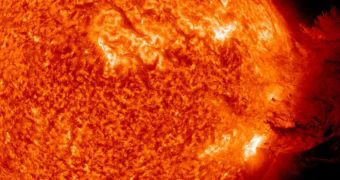The NASA Solar Dynamics Observatory (SDO) is one of the spacecraft that monitors the Sun, and one of our most trusted aids when it comes to warning us about incoming solar flares and coronal mass ejections. Recently, it began its third year studying the solar surface. Here are some of its achievements.
The mission is managed by the NASA Goddard Space Flight Center (GSFC), in Greenbelt, Maryland. It was launched to space aboard an Atlas V 401 delivery system, from Space Launch Complex 41 (SLC-41) at the Cape Canaveral Air Force Station (CCAFS).
Takeoff occurred on February 11, 2010, at 15:23 UTC, and SDO saw its “first light” on March 30, 2010, after completing a complex series of in-orbit assessments and tests. In just two years, the observatory managed to establish itself as one of our best assets for surveying the Sun.
SDO is capable of observing the ever-changing surface of our parent star at multiple wavelengths, using a suite of scientific instruments that included the Atmospheric Imaging Assembly (AIA), the Helioseismic and Magnetic Imager (HMI) and the Extreme Ultraviolet Variability Experiment (EVE).
Since it began its science mission, the spacecraft was able to collect data on more than 1,000 outbursts that occurred on the solar surface. These events include coronal mass ejections and solar flares.
In 2011, AIA was used to measure the constantly-changing magnetic field of the Sun, providing solar physicists with additional insights into the star's inner working. The instrument captures an image of the entire solar disk – at multiple visible and ultraviolet wavelengths – every 12 seconds.
Data collected by this instrument also revealed huge amounts of material swirling around high in the solar atmosphere, a phenomenon that left many experts baffled. At the same time, it produced a large number of amazing, highly-detailed images.
AIA was also used to observe magnetic field ripples, structures that were hypothesized to exist a long time ago, but which were never discovered before. Interestingly, scientists noticed that the instrument can also study comets. Last year, it saw such a body as it plunged into the Sun.
Using EVE, the SDO team continued to keep track of the total output of extreme ultraviolet light from the Sun throughout 2011. This is important because these radiations provide most of the energy responsible for heating our planet.
“The HMI team's first release of vector magnetogram data was of one specific area of the sun, named Active Region 11158, which on February 15, 2011 produced the first X-class flare of the current solar cycle,” NASA experts say in a press release.
“These HMI observations watched the active region as it crossed the face of the sun from February 12-16, 2011 and did something never before possible: show the energy building up in the twisting sunspots over several days before the solar flare eruption,” the statement adds.
“The magnetogram movies show the details of the flow near the swirling sunspots and a sudden change in the horizontal field at the time of the flare,” the document concludes.
SDO is scheduled to continue monitoring the Sun for years to come. Experts planned the mission with a life span of 5 to 10 years. How much time it spends in orbit depends on the amount of funding NASA has available to support it.

 14 DAY TRIAL //
14 DAY TRIAL //